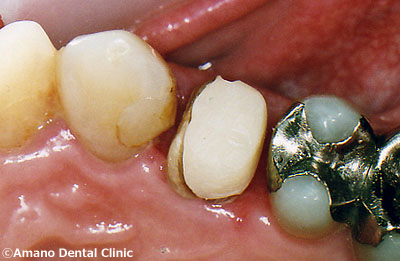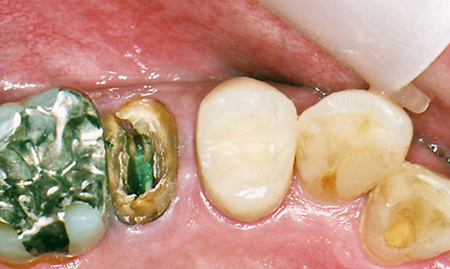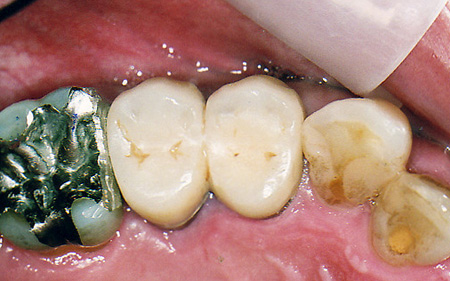After the nerve is removed, teeth die and become fragile. In order to reinforce the teeth, a core (traditionally made of metal) is placed into a canal where the nerve is removed from in order to anchor a crown. A fiber-resin core has various advantages over a metal core.
It is more beneficial to use a fiber core than a metal core.
● Chemically bonds with teeth well
Although a metal core bonds with teeth, the core, adhesive, and teeth are not completely unified. They are stuck together only by an adhesive that flows into the small grooves of the core and teeth. (Mechanical bond)
If the adhesive leaks out, there would be a space between the core and teeth. It will cause a cavity, and even a tooth crack.
A fiber core behaves similarly to the teeth. Because of that, the fiber resin core, adhesive, and teeth are more likely to be unified. (Chemical bond)
● Unlikely to cause a cracked root
A metal core separated from the adhesive and wedging the root often cracks the root. A fiber resin core, however, is unlikely to have the same problem because it can be united with a root.
● Non-corrodible
A metal core is corrodible because it contains a silver alloy. On the other hand, a fiber resin core is solely made of fiber resin, which will not decompose.
● Do not produce a silver ion
Unlike a metal core, a fiber resin core does not produce a silver ion, which causes a discoloration of the roots.
● Similar elasticity as teeth
Metal core’s inflexibility can cause a tooth to crack. Because a fiber resin core is as elastic as teeth, the tooth is unlikely to crack.

The patient sought a second opinion about a cracked root. The cracked root was clearly seen after removing a metal core (lower part of the root is shown in the photograph). Fortunately the crack had not extended to the tip of the root, and we were able to insert a fiber resin core.

The second photograph shows the tooth after the fiber-resin core had been inserted. The core was bonded to the tooth to prevent further cracking. Also, crown lengthening was performed to reposition the gum line. Then the tooth was sustained with a crown.

This patient also sought a second opinion about a cracked root, and we saw the cracked root being in exactly the same condition as the previous patient. We decided to give the fiber core treatment, and also a crown lengthening treatment to reposition the gum line and sustain the tooth. Additionally, a crown was removed from the next tooth and fixed with a two-tooth crown to support the cracked root.


The second photograph shows the tooth after the crown lengthening treatment. The tooth has a fiber resin core. A crown was removed from the tooth next to it, which had no nerve and a metal core had previously been placed.
The third photograph shows the teeth after the treatment. The tooth was fixed with a two-tooth crown.